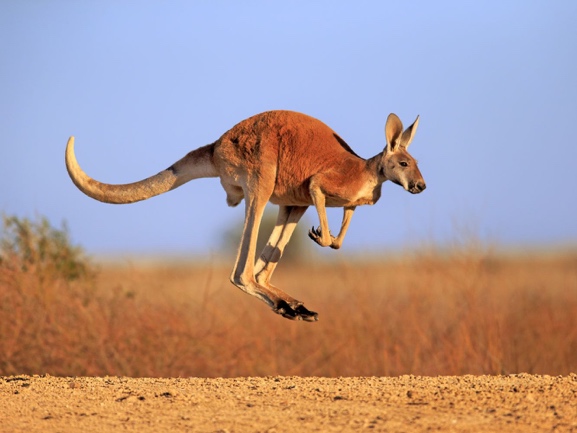
General Information
A member of the marsupial family is the red kangaroo, also endemic to Australia. The red kangaroo is one of the most prominent members of the kangaroo family. This animal lives in the savannah areas of Australia, and therefore it can do without fluids for a long time. Like other members of the genus, red kangaroos are exclusively herbivores with a diet of grains, grasses, and flowering plants typical of the low water areas of the Australian savannah. Kangaroo cubs live in their mother’s pouch for up to eight months, during which time red kangaroos often give birth to a new calf that will use the mother’s second teat. The entire body of the red kangaroo is wrapped in fine red fur.
Skull structure
The skull of the red kangaroo is broad and has large ears attached to it, raised to the top. For this reason, the animal has excellent hearing, which allows it to hunt more effectively. The animal’s lower jaw is almost devoid of teeth but instead ends with two massive, long teeth, as if fused into one. The kangaroo’s upper jaw has up to eight hard teeth, which are designed to eat grass. The middle of the jaw has no teeth, and the remnants of them are located only at the base of the tongue. In this area, the kangaroo chews the ingested food before swallowing. The skull also has a large nasal opening, above which there are two protruding outgrowths of the upper nasal bone. On the upper part, on either side of the central axis, there are two deep openings under the eyeballs.
Structure of the postcranial skeleton
The body length of the red kangaroo can reach 1.5-2 meters, with a body weight of up to 85 kilograms. For females, these figures are minor, indicating the presence of sexual dimorphism in this species. The kangaroo is characterized by a peculiar structure of the limb-girdle. The front paws are long and start directly at the thoracic spine. As such, the kangaroo has no shoulders. The forearm area is strongly elongated in the forelimbs, consisting of two bones, like in humans. The lower limbs are based on strong long shins, which are paramount for the kangaroo’s efficient movement. The hips are also thickened and strong to allow for springy movement. The lower limbs are connected to the spines by the pelvic bones. The tail is long and robust so that the kangaroo can lean on it during a fight with a competitor.